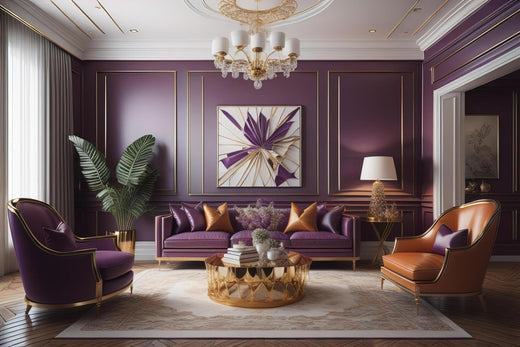
5 Ways to Use Colour Psychology in Interior Design
Share
Colours are not just about aesthetics; they have a profound psychological impact on the way we feel and behave. In interior design, understanding the effects of colours can help create spaces that not only look beautiful but also cater to the emotional needs of the people who inhabit them. Whether it’s a bedroom that promotes relaxation or a workspace that fosters creativity, colour plays a crucial role in shaping the mood and energy of a room.
Here are 5 effective ways to use colour psychology to enhance your interior designs and create spaces that feel just right:
1. Calming and Relaxing Spaces with Blue and Green
If you’re looking to create a tranquil environment, shades of blue and green are your best friends. These colours are scientifically proven to induce feelings of calmness and relaxation, making them perfect for bedrooms, living rooms, or spaces designed for rest and rejuvenation.
-
Blue is associated with tranquility and peace. It has a cooling effect that reduces stress and anxiety. Lighter blues like pastel blue or sky blue are great for bedrooms, as they help promote better sleep and a restful atmosphere. Deeper blues can work well in study areas or offices to encourage concentration.
- Green symbolizes nature and balance. It is known to reduce fatigue and bring a sense of calm. Green tones like sage, mint, or olive can be used in living rooms or meditation spaces to create a soothing, grounding atmosphere. It also promotes healing and relaxation, making it ideal for spaces designed for self-care.
Tip: Pair these colours with natural materials like wood or indoor plants to enhance the calming vibe. These colour choices are also perfect for designing restful sanctuaries or spaces where you want to unwind.
2. Energizing and Motivating Spaces with Yellow and Orange
For spaces that require energy and vibrancy—like a creative studio or a lively kitchen—yellow and orange can be excellent choices. These warm colours are associated with happiness, optimism, and creativity.
-
Yellow is often referred to as the colour of happiness. It has the ability to stimulate mental activity and bring a sense of cheer to any room. Using yellow in kitchens, dining rooms, or offices can create an inviting atmosphere, encourage communication, and boost productivity.
- Orange, on the other hand, is often seen as an energizing and enthusiastic colour. It stimulates creativity, encourages social interactions, and evokes warmth. It’s perfect for playrooms, kitchens, or even home bars.
Tip: Use these colours in moderation. Bright yellow or orange walls may be overwhelming in large doses, but accents in the form of cushions, artwork, or small furniture pieces can bring the right amount of vibrancy to a space.
3. Sophisticated and Luxurious Spaces with Purple and Gold
For spaces where luxury, elegance, and sophistication are key, consider using purple and gold. These rich, deep hues evoke a sense of opulence and grandeur, making them perfect for high-end living rooms, dining areas, or even bathrooms.
-
Purple is historically associated with royalty and wealth. It adds a regal touch to any room and is often used to create a rich, dramatic atmosphere. Dark purple, plum, and lavender can be used in accent walls, fabrics, or furniture to add depth and richness to a space.
- Gold is a symbol of luxury and wealth. When paired with purple or even green, it can enhance the regal, extravagant feel of a room. Gold accents on furniture, light fixtures, or wall art can elevate the elegance of a space without overpowering it.
Tip: Balance these bold colours with neutral tones like black, grey, or white to keep the space feeling grounded and not too overwhelming.
4. Neutral and Grounding Spaces with Beige and Grey
When in doubt, neutral tones like beige, grey, and white offer versatility and a sense of calm. These colours are timeless, and they provide a soothing backdrop that allows other design elements to shine without overwhelming the senses.
-
Beige is an earthy tone that fosters a sense of stability and comfort. It works well in living rooms, bedrooms, or any area where you want to create a welcoming and serene environment.
- Grey is elegant and sophisticated, making it an ideal colour for modern and minimalist interiors. It provides a calm foundation for other bolder colours or can be used on its own for a sleek, contemporary look.
Tip: Combine these neutrals with pops of vibrant colour through art, furniture, or accessories to add personality and visual interest without detracting from the overall serene atmosphere.
5. Balanced and Harmonious Spaces with White and Earthy Tones
If you want to create a sense of balance and harmony in your home, white and earthy tones like brown and terracotta can bring a serene and welcoming ambiance to any room. These colours are versatile and can be used in both traditional and modern spaces.
-
White symbolizes purity, cleanliness, and simplicity. It’s often used as the base colour in interior design and helps make spaces feel open, airy, and bright. It can be paired with almost any colour, and it works beautifully in smaller spaces to make them feel larger and more expansive.
- Earthy tones like brown, terracotta, and taupe are grounded and connect with nature. They evoke a sense of warmth and comfort, making them ideal for creating spaces that feel cozy and inviting.
Tip: Use white as a primary colour and complement it with earthy tones for a well-balanced space. These colours can be easily integrated into different styles, from boho-chic to Scandinavian-inspired interiors.
Conclusion
Using colour psychology to influence the emotional impact of your interiors can truly elevate the atmosphere of your home or workspace. By understanding how colours affect mood, energy, and behavior, you can curate spaces that are not only visually appealing but also emotionally fulfilling. Whether you aim for tranquility with blues and greens or energy with yellows and oranges, colour is a powerful tool that can transform any interior.
So, the next time you’re working on a design project, take a moment to think about the emotions you want to evoke and choose your colours accordingly. A thoughtfully designed space, where every colour serves a purpose, will undoubtedly make a lasting impression.



